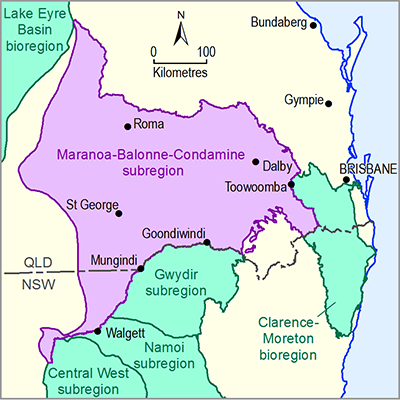- Home
- Assessments
- Bioregional Assessment Program
- Maranoa-Balonne-Condamine subregion
- 3-4 Impact and risk analysis for the Maranoa-Balonne-Condamine subregion
- 3.4 Impacts on and risks to landscape classes
- 3.4.2 Landscape classes that are unlikely to be impacted
Within the assessment extent of the Maranoa-Balonne-Condamine subregion, landscapes outside the zone of potential hydrological change, where impacts are very unlikely (Table 8), include:
- 35,281 km2 of remnant vegetation, including 5846 km2 classified as ‘Floodplain or lowland riverine’; 1670 km2 classified as ‘GAB GDEs’; 2815 km2 classified as ‘Non-floodplain or upland riverine’; and 24,949 km2 classified as ‘Dryland remnant vegetation’
- 59,841 km of streams, including 28,850 km of lowland streams; 23,548 km of upland streams; and 7443 km of streams that access GAB aquifers
- 1612 km2 of wetlands, including 1326 km2 classified as ‘Floodplain or lowland riverine’; 11 km2 as ‘GAB GDEs’; and 276 km2 as ‘Non-floodplain or lowland riverine’
- 177 springs, including 153 springs that are hydrologically connected to GAB aquifers and 24 springs that access non-GAB aquifers, such as the basalt aquifers of the Main Range Volcanics
- 93,044 km2 of productive landscapes used for grazing and dryland agriculture.
Springs, near-permanent or temporary wetlands, and lowland streams are part of 12 landscape classes located outside the zone of potential hydrological change. These landscape classes include 694 km2 of wetland vegetation and 329 km of near-permanent streams, which cover less than 0.1% of the assessment extent.
None of the subregion’s 177 springs, which includes 153 GAB springs and 24 non-GAB springs, are contained within the zone of potential hydrological change. Further, none of the GAB springs are within 50 km of where there is at least a 5% chance of exceeding 0.2 m drawdown due to additional coal resource development in the GAB source aquifer identified for each spring (Office of Groundwater Impact Assessment, Dataset 5; Bioregional Assessment Programme, Dataset 6).
GAB springs refer to active spring ecosystems that have been identified and verified by field mapping by the Queensland Government (Fensham et al., 2012). Other GDEs included in the landscape classification, including those associated with the stream network, are derived from GDE mapping rule sets based on local and expert knowledge, but are not necessarily verified by field observations (DSITI, 2015).
The 2016 Underground water impact report for the Surat Cumulative Management Area (OGIA, 2016) identifies 16 spring complexes, including 4 listed under the Commonwealth’s Environment Protection and Biodiversity Conservation Act 1999 (EPBC Act), and 19 watercourse springs as potentially impacted by groundwater drawdown in excess of 0.2 m associated with baseline CSG production. These 16 spring complexes are connected to GAB aquifers and are located outside of the zone of potential hydrological change. The 2012 Underground water impact report for the Surat Cumulative Management Area (QWC, 2012) identified 13 spring complexes, including 5 listed under the EPBC Act, and 22 watercourse springs as potentially impacted by groundwater drawdown in excess of 0.2 m associated with baseline CSG production.
None of the 24 non-GAB springs in the assessment extent that are associated with the Main Range Volcanics basalt aquifers are potentially impacted due to additional coal resource development. The Underground water impact report for the Surat Cumulative Management Area (OGIA, 2016) does not consider potential impacts to non-GAB springs:
Springs associated with the Main Range Volcanics to the north, south and west of Toowoomba are associated with local flow systems and are disconnected from the regional flow regimes in the underlying GAB formations.
As it is very unlikely that there will be any impacts on those landscape classes outside the zone of potential hydrological change, they are ruled out and not considered further. The following sections provide information on landscape classes within each landscape group that are potentially impacted by hydrological changes due to additional coal resource development.
Table 8 Extent of landscape classes contained in the assessment extent, outside the zone of potential hydrological change and in the zone of potential hydrological change that is outside of the open-cut coal mine pits associated with the two additional coal resource developments, New Acland Coal Mine Stage 3 and The Range coal mine
aExtent of each landscape class is either an area of vegetation (km2), length of stream network (km) or number of springs (number).
GAB = Great Artesian Basin, GDE = groundwater-dependent ecosystem
Data: Bioregional Assessment Programme (Dataset 7)

Product Finalisation date
- 3.1 Overview
- 3.2 Methods
- 3.3 Potential hydrological changes
- 3.4 Impacts on and risks to landscape classes
- 3.4.1 Overview
- 3.4.2 Landscape classes that are unlikely to be impacted
- 3.4.3 'Floodplain or lowland riverine (including non-GAB GDEs)' landscape group
- 3.4.4 'GAB GDEs (riverine, springs, floodplain or non-floodplain)' landscape group
- 3.4.5 'Non-floodplain or upland riverine (including non-GAB GDEs)' landscape group
- 3.4.6 'Human-modified' landscape group
- References
- Datasets
- 3.5 Impacts on and risks to water-dependent assets
- 3.6 Commentary for coal resource developments that are not modelled
- 3.7 Conclusion
- Citation
- Acknowledgements
- Contributors to the Technical Programme
- About this technical product
